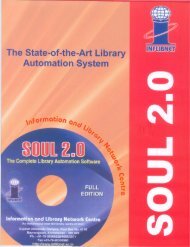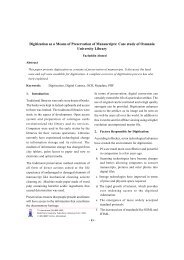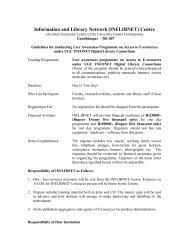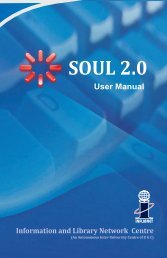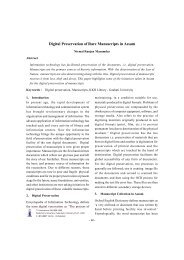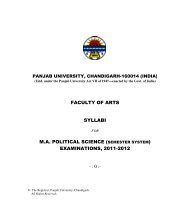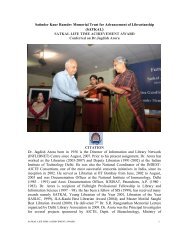Vol.19- No.1 (Jan-Mar, 2012) - INFLIBNET Centre
Vol.19- No.1 (Jan-Mar, 2012) - INFLIBNET Centre
Vol.19- No.1 (Jan-Mar, 2012) - INFLIBNET Centre
You also want an ePaper? Increase the reach of your titles
YUMPU automatically turns print PDFs into web optimized ePapers that Google loves.
scholars, university representatives or research supervisors maysubmit theses to Shodhganga by registering themselves onShodhganga. He explained that the universities are required tosign an MOU with IN FLIBN ET <strong>Centre</strong> in order to join andparticipate in Shodhganga programme. This MOU delineate theresponsibilities of individual universities and <strong>INFLIBNET</strong>. Bysigning the MOU, universities are entitled to get funds fordigitizing and archiving their old theses, get access to antiplagiarismsoftware and deter plagiarism of scholarly content.Shri Manoj Kumar also described a complementary initiativecalled Shodhgangotri that provides for submission of electronicversion of approved synopsis submitted to the universities forregistering the students in Ph.D programmes. He clarified thatShodhgangotri intends to highlight the trends and directions ofresearch being conducted across the country, thereby preventduplication of research. Once the Ph.D degree is awarded andthe full-text thesis is submitted to Shodhganga, a link to thefull-text would be provided from Shodhgangotri to Shodhganga.Technical Session - III: Di'l'itization and Di'l'italArchivin'l' of Theses and DissertationsChairperson: Prof. Karmeshu, Dean, SCSS, jNU, New DelhiRapporteur: Mr. Amar Singh Yadav, jNU, New DelhiProf. Uma Kanjilal made a detailed presentation on IGNOU'sinstitutional repository called "E-Gyankosh", web casting facilityfor Gyandarshan I & II and Gyanvani. She mentioned that theinstitutional repository was started in 2005 to store, index,preserve, distribute, share the distance learning resources. Itprovides access to 95% of the self instructional materialproduced by the university, metadata links to 1600+ videoprogrammes available on You Tube and has more than 1.5 millionregistered users. The repository gets 400 visitors daily. Shementioned that the flexi-learn programme of the universityenables users to access free and open courses. The students canregister and explore the courses, their content. and coverageand thus gain knowledge and skills in any course of their interest.She mentioned that the University follows OER (open EducationalResources) policy like other organizations at international levelsuch as MIT http://web.mit.edu/education/, Open Universityhttp://openlearn.open.ac.uk/, CO L,U N ESCO ,0 LI-CM U, RiceUniversity, etc. Prof. Kanjilal discussed the barriers to 0 ERmovement across educational institutions-issues of copyright.file formats of learning resources, standard metadata and theirinteroperability.Dr.T.S. Kumbar, Librarian, lIT. Gandhinagar highlighted variousETD initiatives taken at national and international levels includingIndCat (Theses Database), Vidhyanidhi, DELN ET. NASSDOC.openMed@NIC, Librarian's Digital Library, Open Index initiative,NDLTD, DART. Diva, PQDT Open, EThOS, Theses Canada, ADT.dissertations Online, NARCIS, etc. He also elaborated on ETDdiscovery tools like DOAR- Directory of open Access InstitutionalRepositories, OAlster worldCat. scientificcommons.org, BASE:Bielefeld Academic Search Engine, CASSIR: Cross archive SearchService for Institutional Repositories. Dr. Kumbar identified 48indicators based on the survey conducted among libraryprofessionals in the country, which could be used for setting upand maintaining ETDs. He also ranked ETDs according to theratings given by experts in the library field based on theseindicators.Dr. S. Majumdar elaborated upon the potential of ETDs andinitiatives taken at national and international levels such asVidhyanidhi, Indian Institute of Science, Indian Council of SocialSciences, NDLTD, ADT. ETD of Brazalian Universities, DARTEurope, Diva, EthOS (UK), National ETD Portal of South Africa,RCAAP, Theses Canada, WorldCAT, etc. He dwelt upon theinitiatives taken by the University of Delhi in creating an ETDarchive from retrospect including 13,000 M. Phil and 15,000Ph.D theses. He mentioned that the project was undertaken bythe University in two phases. In the first phase, all the thesesthat were submitted from inception of the university up to 1979were digitized and in the second phase all the theses submittedfrom 1 980 to 2003 were digitized. Dr. Majumdar expressedconcern over many challenging issues related to setting up andmaintenance of ETDs like quality control over content. adoptionof standard metadata schema, file formats, long-termpreservation strategy, standards for providing bibliographicalreferences, etc. He expressed that the user community need tobe sensitized to the practice of anti-plagiarism, fair use andintellectual property rights.Technical Session - IV:ETD Systems Selection and UseChairperson: Dr. H K Kaul. Director, DELNETRapporteur: Mr. Somesh, jNU, New DelhiDr ARD Prasad dwelt upon OAl-ORE (Open Archives InitiativeObject Resuse and Exchange) implementation to DSpacerepositories. OAl-ORE defines standards for the description andexchange of aggregations of web resources. (http://www.openarchives.org/ore). He mentioned that thisimplementation will enable IN FLIBN ET to collect digital objectsfrom re[X)sitories across the country.Vol. 19, <strong>No.1</strong> Oanuary to <strong>Mar</strong>ch <strong>2012</strong>) ------------------------------- 7


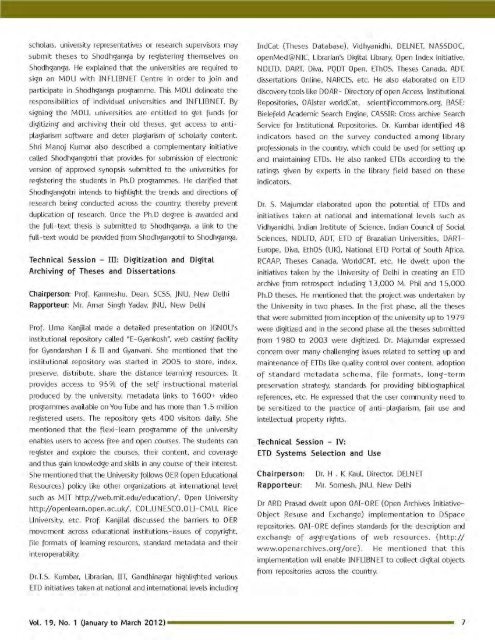
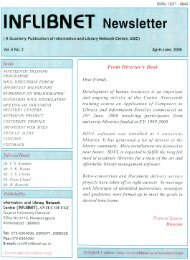


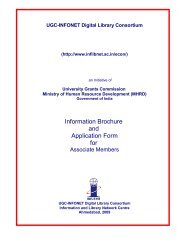
![Uni of Delhi_MA_History[1]. - INFLIBNET Centre](https://img.yumpu.com/48586372/1/190x245/uni-of-delhi-ma-history1-inflibnet-centre.jpg?quality=85)
